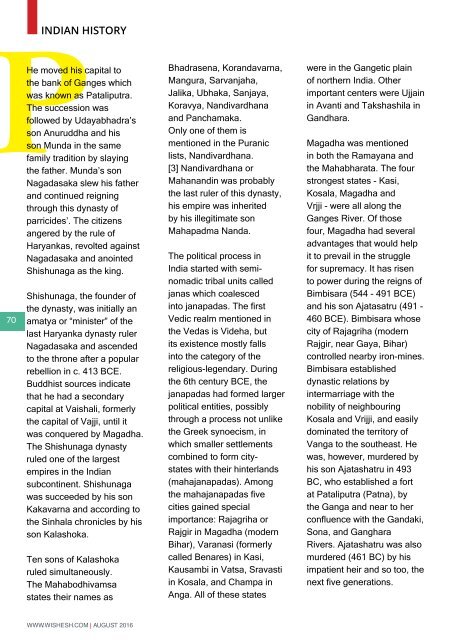Wishesh Magazine August 2016
Here is the Latest August Edition of Wishesh Magazine. Guru Poornima as a cover story and more Interesting Stories of Healthy Living, Indian Yoga, Business, Fashion, Desi News, NRI Profiles, Indian Events, Automobiles, Movie Reviews and Many More exciting stories on Wishesh Magazine.
Here is the Latest August Edition of Wishesh Magazine. Guru Poornima as a cover story and more Interesting Stories of Healthy Living, Indian Yoga, Business, Fashion, Desi News, NRI Profiles, Indian Events, Automobiles, Movie Reviews and Many More exciting stories on Wishesh Magazine.
Create successful ePaper yourself
Turn your PDF publications into a flip-book with our unique Google optimized e-Paper software.
INDIAN HISTORY<br />
70<br />
He moved his capital to<br />
the bank of Ganges which<br />
was known as Pataliputra.<br />
The succession was<br />
followed by Udayabhadra’s<br />
son Anuruddha and his<br />
son Munda in the same<br />
family tradition by slaying<br />
the father. Munda’s son<br />
Nagadasaka slew his father<br />
and continued reigning<br />
through this dynasty of<br />
parricides’. The citizens<br />
angered by the rule of<br />
Haryankas, revolted against<br />
Nagadasaka and anointed<br />
Shishunaga as the king.<br />
Shishunaga, the founder of<br />
the dynasty, was initially an<br />
amatya or “minister” of the<br />
last Haryanka dynasty ruler<br />
Nagadasaka and ascended<br />
to the throne after a popular<br />
rebellion in c. 413 BCE.<br />
Buddhist sources indicate<br />
that he had a secondary<br />
capital at Vaishali, formerly<br />
the capital of Vajji, until it<br />
was conquered by Magadha.<br />
The Shishunaga dynasty<br />
ruled one of the largest<br />
empires in the Indian<br />
subcontinent. Shishunaga<br />
was succeeded by his son<br />
Kakavarna and according to<br />
the Sinhala chronicles by his<br />
son Kalashoka.<br />
Ten sons of Kalashoka<br />
ruled simultaneously.<br />
The Mahabodhivamsa<br />
states their names as<br />
Bhadrasena, Korandavarna,<br />
Mangura, Sarvanjaha,<br />
Jalika, Ubhaka, Sanjaya,<br />
Koravya, Nandivardhana<br />
and Panchamaka.<br />
Only one of them is<br />
mentioned in the Puranic<br />
lists, Nandivardhana.<br />
[3] Nandivardhana or<br />
Mahanandin was probably<br />
the last ruler of this dynasty,<br />
his empire was inherited<br />
by his illegitimate son<br />
Mahapadma Nanda.<br />
The political process in<br />
India started with seminomadic<br />
tribal units called<br />
janas which coalesced<br />
into janapadas. The first<br />
Vedic realm mentioned in<br />
the Vedas is Videha, but<br />
its existence mostly falls<br />
into the category of the<br />
religious-legendary. During<br />
the 6th century BCE, the<br />
janapadas had formed larger<br />
political entities, possibly<br />
through a process not unlike<br />
the Greek synoecism, in<br />
which smaller settlements<br />
combined to form citystates<br />
with their hinterlands<br />
(mahajanapadas). Among<br />
the mahajanapadas five<br />
cities gained special<br />
importance: Rajagriha or<br />
Rajgir in Magadha (modern<br />
Bihar), Varanasi (formerly<br />
called Benares) in Kasi,<br />
Kausambi in Vatsa, Sravasti<br />
in Kosala, and Champa in<br />
Anga. All of these states<br />
were in the Gangetic plain<br />
of northern India. Other<br />
important centers were Ujjain<br />
in Avanti and Takshashila in<br />
Gandhara.<br />
Magadha was mentioned<br />
in both the Ramayana and<br />
the Mahabharata. The four<br />
strongest states - Kasi,<br />
Kosala, Magadha and<br />
Vrjji - were all along the<br />
Ganges River. Of those<br />
four, Magadha had several<br />
advantages that would help<br />
it to prevail in the struggle<br />
for supremacy. It has risen<br />
to power during the reigns of<br />
Bimbisara (544 - 491 BCE)<br />
and his son Ajatasatru (491 -<br />
460 BCE). Bimbisara whose<br />
city of Rajagriha (modern<br />
Rajgir, near Gaya, Bihar)<br />
controlled nearby iron-mines.<br />
Bimbisara established<br />
dynastic relations by<br />
intermarriage with the<br />
nobility of neighbouring<br />
Kosala and Vrijji, and easily<br />
dominated the territory of<br />
Vanga to the southeast. He<br />
was, however, murdered by<br />
his son Ajatashatru in 493<br />
BC, who established a fort<br />
at Pataliputra (Patna), by<br />
the Ganga and near to her<br />
confluence with the Gandaki,<br />
Sona, and Ganghara<br />
Rivers. Ajatashatru was also<br />
murdered (461 BC) by his<br />
impatient heir and so too, the<br />
next five generations.<br />
WWW.WISHESH.COM | AUGUST <strong>2016</strong>

















